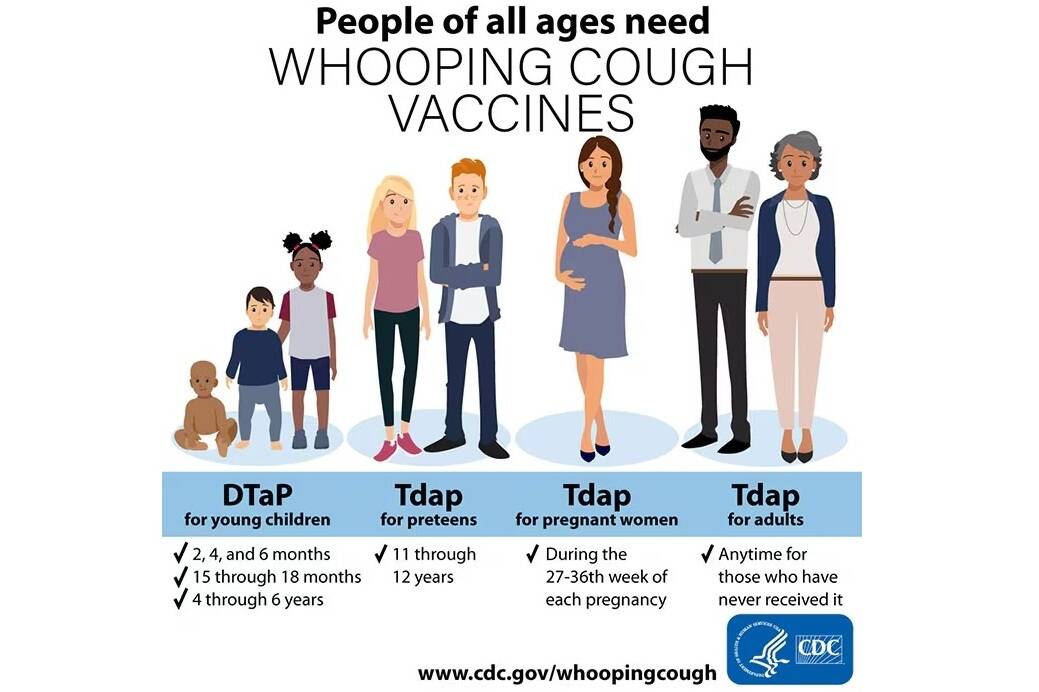Whooping cough is on the rise in South King County.
According to Public Health – Seattle & King County, there are more cases so far this year than the last three years combined.
While most of the local cases are coming from the Auburn, Kent, and Federal Way areas, this is a pattern being observed across the country.
“There has been… a sharp increase in the number of cases that have been reported to the [Centers for Disease Control and Prevention],” Libby Page, an immunization program manager with Public Health, said in a recent interview. “So we’re really trying to make sure that our community is aware of the increase in whooping cough cases and can take take measures to get themselves and their children vaccinated.”
Tracking whooping cough cases can be difficult because not all cases are reported, meaning a truly accurate count is hard to figure.
But so far this year, 100 cases of whooping cough – also known as pertussis – have been reported to Public Health. This number is expected to increase as the weather cools and more people begin gathering inside, Page said.
Seventy of those cases were reported in the last 90 days (as of July 11), and of those cases, 49 of them (70%) have been in South King County.
Additionally, 43 of the total cases were in children 18 and younger, again with most of these cases stemming from the Federal Way, Kent, and Auburn areas.
Three infants, and one child under 5, and one adult over 65 have been hospitalized with whooping cough so far this year, Libby said,
This is all compared to the 31 total cases last year, 15 cases in 2022, and six in 2021.
WHY THE RISE?
While cases are on the rise, the CDC says this is more of a return to pre-COVID-19 pandemic normal.
But that doesn’t mean there are variables that have helped the spread of the disease on.
One is that whooping cough, like many other diseases, have an epidemiologic cycle – roughly every five years, there’s a “blip” in the number of cases, Page said.
For example, King County’s last spike was in 2015, with a total of 252 cases; prior to that, 895 cases in 2012.
Why we skipped a possible rise in cases in 2019 could have been two side effects of the aforementioned pandemic.
First is the masking, hand washing, and social distancing.
“…[W]e were all taking protective measures that prevented the spread of a lot of respiratory illnesses,” Page said.
But there was also a disruption of vaccine delivery and access.
“So we’re seeing that there are a number of people who are not up to date on their TDAP vaccine, which is reductive against whooping cough,” Page continued.
And finally, cases are on the rise in South King County specifically because these areas have less access to health care.
“Historically, a lot of community members face access barriers to health case: they may not have insurance; they may not have a primary care provider; transportation challenges,” Page said. “As a result to all those barriers… those reasons of the county are under-immunized, especially children.”
VACCINE UPDATES
This will probably sound familiar: while Page recommends everyone gets their whooping cough vaccine, she specifically stressed infants, seniors, the immunocompromised, and mothers.
There are two vaccines, split among the age groups.
For those 18 and older, there’s the TDAP vaccine, which not only vaccinates against whooping cough, but tetanus and diphtheria as well.
Public Health recommends adults 19 and older get a Tdap vaccine now – especially if they have close contact with infants – and update it every ten years.
Then there’s the DTaP vaccine; the difference between this vaccine and the adult version is that the DTaP are full vaccine doses, whereas the Tdap vaccine has a full dose of tetanus but smaller doses of the diphtheria and whooping cough vaccine.
It’s recommended infants and toddlers get five TDaP vaccines – their first dos when they are two months old, and the last before kindergarten.
Finally, Page urged women to get a TDaP vaccine every time they get pregnant, as their immunity is often transferred to their child.
According to Page, the mothers of the three infants that were hospitalized did not have their TDaP vaccine. The vaccine status of the other individuals that were hospitalized is unknown.
“That really… illustrates how giving the parent immunity and passing that on to the infant who’s too young to be vaccinated is such a critical component of our vaccine recommendations,” Page said.
PREVENTING/TREATING WHOOPING COUGH?
Whooping cough can start off like a common cold, Page said, which oftentimes means people don’t go to a primary care provider or urgent care facility to be tested.
These symptoms can last up to two weeks.
More serious symptoms can appear after about a week or two after the initial symptoms start, and include uncontrollable coughing fits (especially at night) that oftentimes sound like a high-pitched “whooping” sound.
Whooping cough is highly contagious and can spread in the air via coughs and sneezes; someone infected can pass on the disease as soon as symptoms appear, and up to three weeks after the coughing begins.
As such, wearing a mask and washing hands are ways to prevent the spread of the disease.
However, unlike COVID-19 and its other strains, whooping cough is a bacterial infection, not a virus. If prescribed antibiotics by a doctor, a patient will become noncontagious after five days of treatment.


